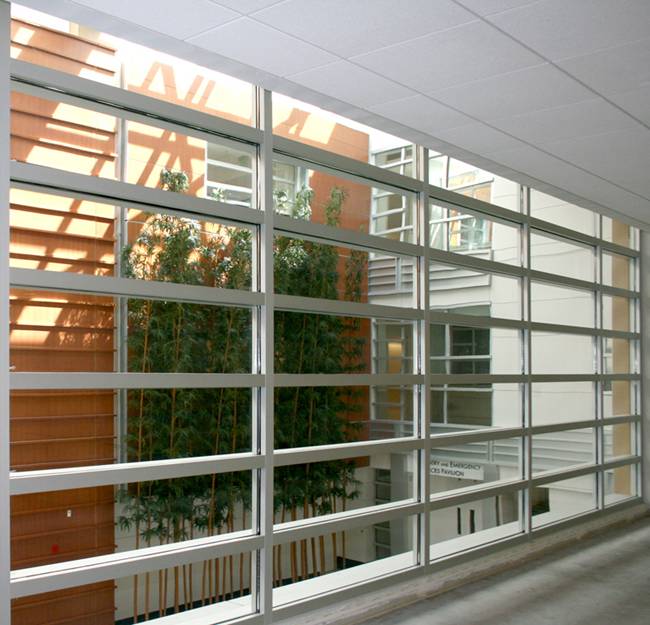Fire Resistive Glass Protects From Radiant Heat

Fire Resistive Glass and Heat Transfer
Fire Resistive Glass Protects from Radiant Heat. Fire Resistive Glass that is tested to the wall standard, ASTM E-119 can protect people and property from the deadly, dangerous transmission of radiant heat. Fire protective glass does not shield radiant heat.
What is Fire Resistive Glass?
These clear, transparent products are designed to contain flames and smoke, and to block the transfer of radiant heat. They are listed by the recognized testing agencies as transparent walls and are not limited to 25% of the wall area due to radiant heat concerns. This allows for unlimited expanses of glazing whenever visibility or light are a desired design element.
 |
SuperLite II-XL 60-120 is a fire resistive glazing product that blocks radiant heat transfer to meet ASTM E119 requirements. Provides maximum fire and impact safety with hose stream and full radiant heat protection up to 2 hours. Tested to the stringent wall standard and when used with an equally rated heat barrier framing system such as SAFTIfireGPX, this glazing provides floor-to-ceiling and wall-to-wall design flexibility with unsurpassed clarity and sound reduction.
 |
SaftiFire GPX framing is a fire resistive, aluminum clad framing system available in multiple profiles. Perfect for fire resistive transparent wall/window assemblies tested to ASTM E-119, which limits temperature-rise to 250° F above ambient on the non-fire side. Click here to view a video on GPX Framing.
So, what exactly is radiant heat?
Radiant heat is invisible, extremely intense, electromagnetic waves that travel at the speed of light with little resistance from air. When these waves strike an object they are absorbed and their energy is converted to heat. If the object is a combustible material, such as paper, fabric, or wood, a fire will start when the material’s ignition temperature is reached. Radiant heat is extremely dangerous to building occupants since it can quickly reach a level that causes unbearable pain, followed rapidly by second degree burns, preventing safe egress. The critical level for unbearable human pain is 5 kilowatts per square meter, and the auto-ignition of wood combustibles is 7.5-13 kilowatts per square meter.
Aren’t radiant heat considerations built into NFPA 80 glazing size area limits?
Simply, no. The recently revised NFPA 80 deletes size limits for glazing materials without considering radiant heat hazards. Only in Appendix J does it caution us to consider radiant heat when selecting glazing materials in large sizes. Again, the burden is on architects, contractors and code officials, who typically are not trained to assess radiant heat control factors and do not always know the relative performance capabilities of various glazing products, to make the appropriate choice of materials.
Can you tell which products limit radiant heat by their labeled ratings?
Sometimes. If you know the test standards well enough, you can. If you know that a glazing product was tested as a transparent wall, which includes temperature rise limits of 250F degrees, you can be confident that it limits the transfer of radiant heat.
However, products that do not limit radiant heat often carry a similar label to those that do reduce radiant heat. Even though a product is listed for a higher rating (i.e., 60-minutes and above) does not mean that it protects against radiant heat. If it does not protect against radiant heat, it cannot be used safely in wall applications; in windows and doors, yes, but not walls.
So, you have to educate yourself on the respective performance levels of products and the information is sometimes hard to discern. For starters, look carefully at the product literature, especially the small print, for any qualifications or limitations to product performance related to radiant heat transfer. Manufacturers should clearly disclose the fact that their products do not limit radiant heat even though they are rated for 60-minutes or more.
Glazing products that limit radiant heat are typically multi-layer laminates or insulated glass. In other words, they are thick in appearance. Monolithic (single layer) or single laminated products do not limit radiant heat transfer. Certain exceptional monolithics, such as SuperLite I-XL by SAFTIFIRST, dramatically reduce radiant heat transfer for a monolithic, but should not be used in any applications without prior AHJ (Authority Having Jurisdiction) approval given their limitations regarding direction and hose stream.
So what glazing products limit radiant heat?
- Insulated products, such as SuperLite II-XL, Pyrostop, Pyrobel, Contraflam, Swissflam, etc. products that are rated 60-minute plus to ASTM E119, limit temperature rise to 250F degrees and reduce radiant heat flux to 0 kilowatts per square meter.
- SuperLite I-XL – a window and door product that reduces radiant heat flux to one kilowatt per square meter at 60 minutes and is like products widely used in Europe that similarly limit radiant heat flux.
And, finally, what products do not limit radiant heat?
- Wired glass allows radiated flux on the unexposed side of 35-38 kilowatts per square meter at 37 minutes.
- Ceramics, such as FireLite and Keralite, allow radiant heat flux of 75 kilowatts per square meter at 60 minutes.